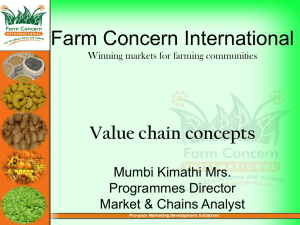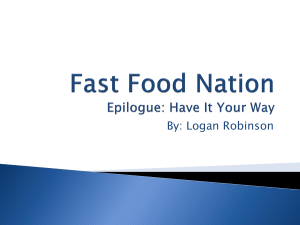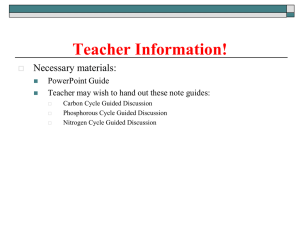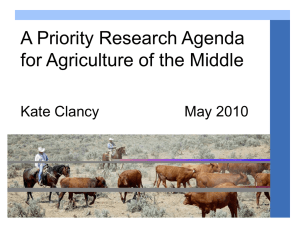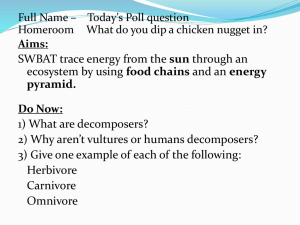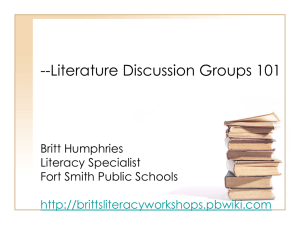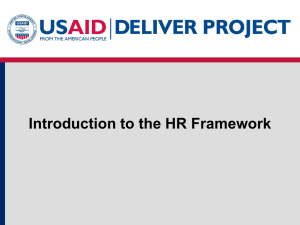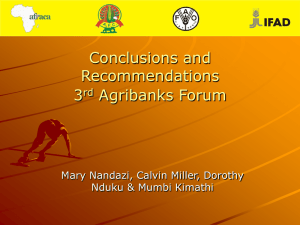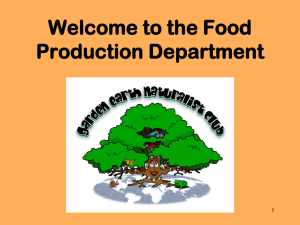Results Chains - The Open Standards for the Practice of Conservation
advertisement
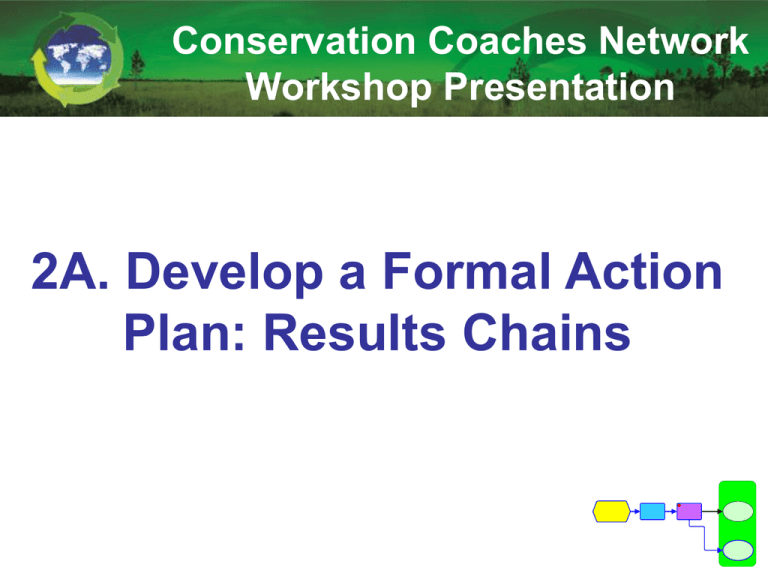
Conservation Coaches Network Workshop Presentation 2A. Develop a Formal Action Plan: Results Chains Adaptive Management Workshop Presentations 1A-1B. Team, Scope, Vision 1B. Conservation Targets 1B. Viability Assessment 2A-1. Strategy Selection 2A-2. Results Chains 2A-3. Goals and Objectives 1C. Threat Rating 1D. Conceptual Models 2B. Monitoring Plan Plan Your Actions & Monitoring Results Chains This Presentation • • • • Results Chains What is a Results Chain How to Develop Results Chains Examples How Project Teams Have Used Results Chains What is a Results Chain? Results Chains A tool for documenting a team’s “theory of change,” describing how a strategy will lead to conservation success What is a Results Chain? Results Chains A diagram of a series of “if…then” causal statements that: • Defines how a project team thinks a strategy will contribute to reducing a threat or restoring a target • Focuses on the achievement of results – not the execution of activities • Is composed of assumptions that can be tested Results Chains Results Chains Implicit Assumptions: Strategy ? ? Conservation target improved What is a Results Chain? Results Chains The Basic Components of a Results Chain: Strategy What is a Results Chain? Results Chains The Basic Components of a Results Chain: Strategy Impact on Target Goal What is a Results Chain? Results Chains The Basic Components of a Results Chain: Strategy Result Strategic action implemented Result (Direct Threat) Objective Objective Contributing factor addressed or opportunity achieved Direct Threat Objective Achieved Impact on Target Goal Impact of actions achieved/ Viability maintained Why Results Chains? Results Chains • Document assumptions • Define how activities will contribute to achieving results • Formulate measures of success Situation Analysis vs. Results Chains Results Chains Situation Analyses: – Shows the situation today helps us to illuminate points of intervention and identify strategies Results Chains: – Starts with selected strategies and helps to illuminate the assumptions leading to the desired results Achieving Success Results Chains SUCCESS! Accurate Results Chain used to design Well executed project leads to used to design Well executed project does not lead to Desired results used to design Poorly executed project does not lead to Desired results used to design Poorly executed project does not lead to Desired results Desired results THEORY FAILURE Inaccurate Results Chain PROGRAM FAILURE Accurate Results Chain TOTAL FAILURE!!! Inaccurate Results Chain What Happens When We Make False Assumptions? Results Chains Training Fly Fishing Guides in Bocas del Toro, Panama Underlying Project Assumptions Results Chains The project team assumed: • • • • • If we train local fishermen as fly fishing guides and we give them fly fishing gear, then they will have the skills and gear to be guides If they have the skills and gear, then they will work as fly fishing guides If they are able to work as fly fishing guides, then they will increase their income If they have increased income, they will not need to fish so much and there will be less unsustainable fishing practices If there are less unsustainable fishing practices, then the coral reef ecosystem will be more conserved. Train Local Fishermen as Fly Fishing Guides Local Fishermen Have Skills & Gear to Be Guides X Local Fishermen Work as Guides Increased income Unsustainable Fishing Reduced Coral Reef Ecosystem Underlying Project Assumptions Results Chains What else did the fishermen need to become fly fishing guides? • • • Clients – tourists and tourism operators needed to know about the fly fishing guides English speaking skills Etc. Train Local Fishermen as Fly Fishing Guides Tourists & tour operators know about guides Local Fishermen Have Skills & Gear to Be Guides Tourists hire guides X Local Fishermen Work as Guides Increased income Unsustainable Fishing Reduced Coral Reef Ecosystem This Presentation • • • • Results Chains What is a Results Chain How to Develop Results Chains Examples How Project Teams Have Used Results Chains One Way to Develop a Results Chain Results Chains 1. Construct an initial results chain 2. Complete the links in the results chain 3. Verify that your results chain meets criteria of a good results chain 4. Add activities to show how your specific actions (activities) will contribute to achieving your results Our Example – Swan Coastal Plain Wetlands Adapted from WWF Australia’s WeltlandsWatch Project Results Chains A Chain From the Model Allows You to… Results Chains A Chain From the Model Allows You to… In Miradi, select the direct threat, rightclick & select “Create Results Chain” Results Chains 1. Construct an Initial Results Chain Results Chains 2. Complete the Links in the Results Chain Spread out initial results: Results Chains 2. Complete the Links in the Results Chain Results Chains 2. Complete the Links in the Results Chain Results Chains 2. Complete the Links in the Results Chain Results Chains 3. Review the Criteria for Good Results Chains • • Results Chains Results oriented: Boxes contain desired results (e.g., reduction of hunting), and not activities (e.g., conduct a study). Connected in a “causal” manner: There are clear connections of “if…then” between each pair of successive boxes. 3. Review the Criteria for Good Results Chains • Results Chains Demonstrates change: Each box describes how you hope the relevant factor will change (e.g., improve, increase, or decrease). 3. Review the Criteria for Good Results Chains • • Results Chains Relatively complete: There are sufficient boxes to construct logical connections but not so many that the chain becomes overly complex. Simple: There is only one result per box. 4. Add Activities Results Chains Activity: A specific action or set of tasks undertaken by project staff and/or partners to reach one or more objectives. Define activities to accomplish your strategy and add them onto the results chain 4. Add Activities Results Chains Activities in Miradi Select this to show main activities on the results chain Results Chains If you have a lot of activities, don’t clutter the results chain with all of them. Keep some hidden. Other Ways to Develop a Results Chain Results Chains Steps: 1)Place strategy, target and threat reduction result 2)Build the chain, either: • Right to left, defining what needs to be done to reduce the threat • Left to right, defining desired results of the strategy • Brainstorming results and then linking them (as in this example) Promote development of legal instruments for grassland protection No new agricultural expansion in grasslands Desert Grassland ecosystems maintained Other Ways to Develop a Results Chain Promote development of legal instruments for grassland protection Land use change petitions in critical grasslands refused New water concessions in grasslands refused No new agricultural expansion in grasslands Results Chains Desert Grassland ecosystems maintained Other Ways to Develop a Results Chain Promote development of legal instruments for grassland protection Government recognizes importance of grasslands & need for revising regulations Stricter criteria developed for grassland mgmt & protection Land use change petitions in critical grasslands refused New water concessions in grasslands refused No new agricultural expansion in grasslands Results Chains Desert Grassland ecosystems maintained Other Ways to Develop a Results Chain Promote development of legal instruments for grassland protection Government recognizes importance of grasslands & need for revising regulations Stricter criteria developed for grassland mgmt & protection Land use change petitions in critical grasslands refused Enforcement of refused petitions New water concessions in grasslands refused Enforcement of refused water concessions No new agricultural expansion in grasslands Results Chains Desert Grassland ecosystems maintained What is NOT a Results Chain? It is not an implementation flow diagram… Results chains focus on the achievement of results not the implementation of activities Results Chains Your Turn: Which of the Following is NOT a Results Chain? A. Lobbying of government for stronger regulations Identify key decision makers Educate decision makers Decision makers pass laws Increased yields B. C. Promotion of sustainable agriculture Community capacity building for forest resource management Farmers implement sustainable agriculture methods Greater indigenous knowledge about rights More permanent crops More control of & vigilance over external actors Results Chains Research & develop regulations Increased permanence of agricultural occupation More illegal wood confiscated No wildlife trade Less conversion of forest to agriculture Less illegal selective logging in indigenous communities Jaguar populations increased Coastal forests conserved Miombo woodland conserved Primary forest conserved This Presentation • • • • Results Chains What is a Results Chain How to Develop Results Chains Examples How Project Teams Have Used Results Chains Your Turn: Add the Missing Result Promotion of certified timber harvesting Loggers knowledgeable about certification Loggers view certified market as profitable ? Results Chains More sustainable harvesting of timber Montane forest diversity maintained Your Turn: Add the Missing Result Promotion of certified timber harvesting Loggers knowledgeable about certification Loggers view certified market as profitable Loggers use certified harvesting methods More sustainable harvesting of timber Montane forest diversity maintained Your Turn: Create a Results Chain Using the Following Results Results Chains Citizens eradicate invasive plants Healthy native wetland vegetation Citizens have skills to eradicate invasive plants Train citizens to eradicate invasive plants Citizens knowledgeable of local invasive plants Invasive plants decreased Result 1a Result 2 Strategy Result 1b Direct Threat Result (3) Target Impact (Result 4) Your Turn: Create a Results Chain Using the Following Results Results Chains Citizens eradicate invasive plants Healthy native wetland vegetation Citizens have skills to eradicate invasive plants Citizens knowledgeable of local invasive plants Invasive plants decreased Result 1a Train citizens to eradicate invasive plants Result 2 Result 1b Direct Threat Result (3) Target Impact (Result 4) Your Turn: Create a Results Chain Using the Following Results Results Chains Citizens eradicate invasive plants Healthy native wetland vegetation Invasive plants decreased Train citizens to eradicate invasive plants Citizens knowledgeable of local invasive plants Result 2 Citizens have skills to eradicate invasive plants Direct Threat Result (3) Target Impact (Result 4) Your Turn: Create a Results Chain Using the Following Results Results Chains Healthy native wetland vegetation Invasive plants decreased Train citizens to eradicate invasive plants Citizens knowledgeable of local invasive plants Citizens have skills to eradicate invasive plants Citizens eradicate invasive plants Direct Threat Result (3) Target Impact (Result 4) Your Turn: Create a Results Chain Using the Following Results Train citizens to eradicate invasive plants Citizens knowledgeable of local invasive plants Citizens have skills to eradicate invasive plants Citizens eradicate invasive plants Invasive plants decreased Results Chains Healthy native wetland vegetation This Presentation • • • • What is a Results Chain How to Develop Results Chains Examples How Project Teams Have Used Results Chains Results Chains How Teams Have Used Results Chains Results Chains • To discuss and refine their theories of change • To be realistic about the time required to achieve results • To recognize when NOT to implement a strategy Refine Theories of Change Brazil nut mgmt plan Mgmt plans implemented Higher quality brazil nut Results Chains Higher income ? Less conversion of forest to ag Adapted from WWF Southwest Amazon Ecoregion (SWA) Brazil nut forest conserved Refine Theories of Change Brazil nut mgmt plan Mgmt plans implemented Higher quality brazil nut Results Chains Higher income Local people committed to forest mgmt Less conversion of forest to ag Adapted from WWF Southwest Amazon Ecoregion (SWA) Brazil nut forest conserved Refine Theories of Change Brazil nut mgmt plan Mgmt plans implemented Higher quality brazil nut Higher quality of life Results Chains Higher income Greater recognition of forest’s economic value Local people committed to forest mgmt Less conversion of forest to ag Adapted from WWF Southwest Amazon Ecoregion (SWA) Brazil nut forest conserved Refine Theories of Change More people buy cattle (as savings) Brazil nut mgmt plan Mgmt plans implemented Higher quality brazil nut More conversion of forest to pasture Results Chains Less Brazil Nut Forest Higher income Adapted from WWF Southwest Amazon Ecoregion (SWA) Refine Theories of Change More conversion of forest to pasture More people buy cattle (as savings) Brazil nut mgmt plan Mgmt plans implemented Higher quality brazil nut Higher quality of life Results Chains Less Brazil Nut Forest Higher income Greater recognition of forest’s economic value Local people committed to forest mgmt Less conversion of forest to ag Adapted from WWF Southwest Amazon Ecoregion (SWA) Brazil nut forest conserved Be Realistic About Time Required to Achieve Results Objective 2010 Objective 2007 Brazil nut mgmt plan Mgmt plans implemented Results Chains Higher quality brazil nut Higher quality of life Higher income Greater recognition of forest’s economic value Objective 2012 Objective 2012 Local people committed to forest mgmt Less conversion of forest to ag Adapted from WWF Southwest Amazon Ecoregion (SWA) Goal 2014 Brazil nut forest conserved Recognizing When NOT To Implement a Strategy Results Chains Should we invest in sustainable agriculture? Increased yields Pilot model of sustainable agriculture Model widely implemented by gov’t Promote marketable cash crops More permanent crops Increased income Increased permanence of agric occupation Less Conversion of Forest to Agriculture Farmer will not convert more land Coastal Forests Miombo Woodland Adapted from Eastern African Coastal Forests Ecoregion (EACFE) Key Points Results Chains • Results oriented, but activities can help the flow • The “If-then” logic must stand up • Make your assumptions & the actor’s incentives explicit • Alternative pathways are OK • Peer review is critical

